Guide to Effective Localization Management Processes
Localizing is simple.
You just provide translators, designers, developers, and managers with the right tools, tasks, and timelines, while ensuring their continuous cooperation.
Well, when put that way, localization management seems a lot less simple.
You could spend years, learning from trial and error, with your budget on the line. Or, you could learn from my comprehensive guide to localization management. It's almost like cheating—but I won't tell.
What is localization management?
Localization management is the process of setting localization strategy and goals, allocating resources, coordinating contributors, and overseeing task delivery. The primary objective of localization project management is the creation of localized products or services within the agreed time, budget, and quality standards.
Benefits of localization management
Among all the benefits of localization management, intact sanity stands out as the most salient one 😉. But let's also examine other benefits of properly managing your localization projects:
- Effective workflow
- Shorter time-to-market
- Cost savings
- Scalability of operations
- Accurate and consistent translations
- Legal and regulatory compliance
- Cultural fit of localized products
How to organize localization project management
Follow these steps to properly organize your localization project:
1. Set project goals and objectives
To set localization project goals and objectives, you need to first understand the constraints under which you'll operate.
Understand project constraints
Large or small, localization projects always revolve around four constraints:
- cost
- time
- scope
- quality
You won't be able to change one constraint without affecting the other three.
For example:
You can localize your entire website (scope), and do it fast (time) and accurately (quality), but it will likely be expensive (cost).

Discover performance targets
What complicates the matters further are performance targets. These are the expectations of key project stakeholders and should be central when setting project goals and balancing constraints.
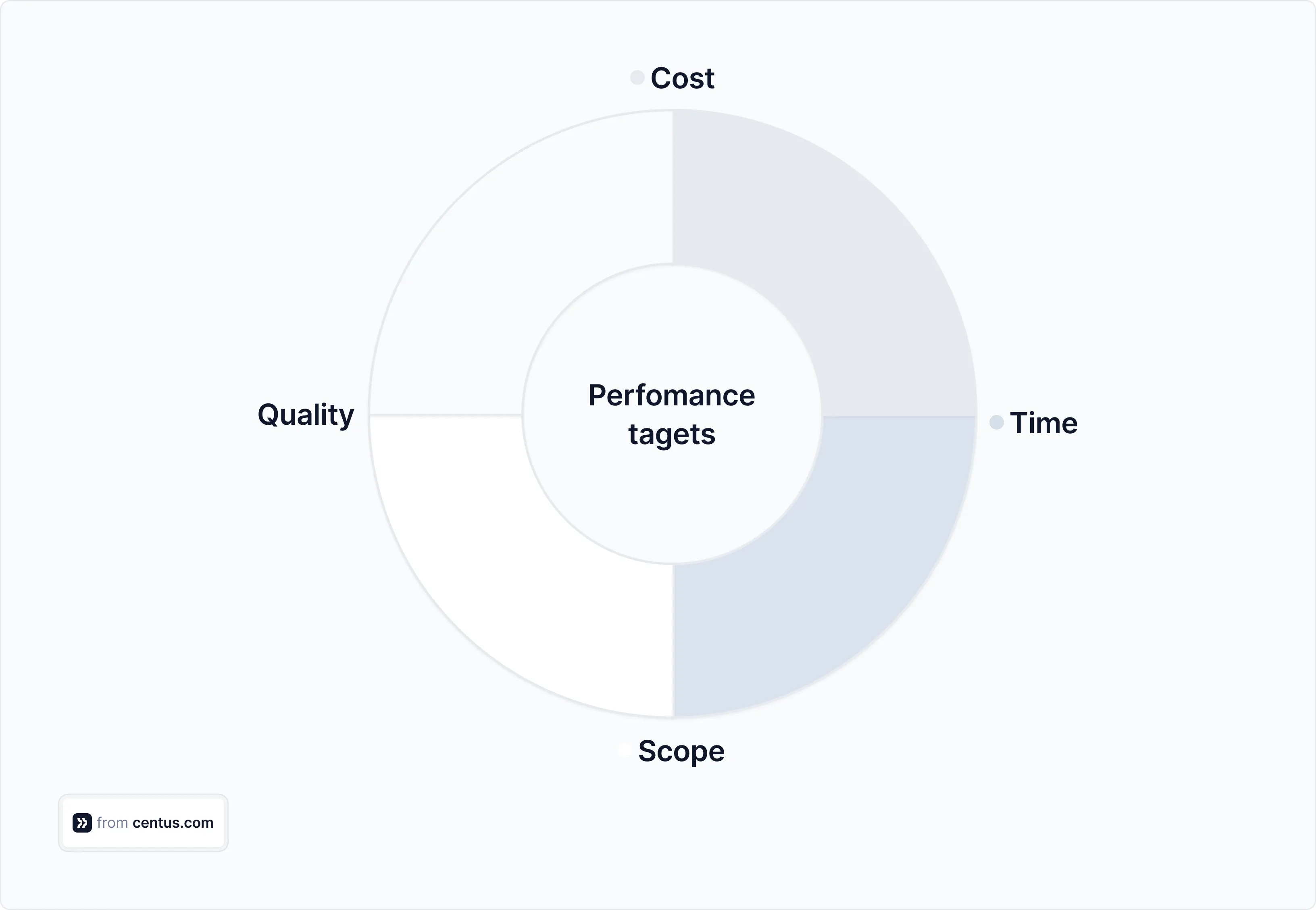
Your company's CEO might want to increase revenue, while your Head of SEO focuses more on the SEO performance of the localized website.
In the pre-production stage of the project, make sure to find out those performance targets and set specific objectives based on them.
The table below shows the common performance targets of localization project stakeholders:
| Role | Performance Target |
|---|---|
| Chief Executive Officer (CEO) | Expand into new markets, increase revenue, and improve customer satisfaction |
| Head of Marketing | Increase local engagement, increase brand awareness, and boost conversion rates |
| Head of SEO | Boost local organic traffic, improve local keywords visibility |
| Head of Customer Support | Offer multilingual support, improve local response times, and increase customer satisfaction in target markets |
| Localization Project Manager | Ensure timely project delivery within budget and to the agreed quality standard, while meeting the performance targets of key project stakeholders |
| Head of Design | Adapt design and UX for local customers and ensure usability across languages |
| Chief Technology Officer (CTO) | Ensure localized versions of the website or app run smoothly |
| Chief Legal Officer (CLO) | Ensure localized products and services comply with local laws, regulations, contractual agreements, and TOS |
| QA Lead | Ensure high product quality across localized versions, minimizing defects, and achieving comprehensive test coverage |
Balance project constraints and performance targets
After establishing performance targets, you need to balance them with project constraints. And here communication is key.
Communicate with all project stakeholders to arrive at trade-offs and ensure their performance targets are realistic under given constraints.
Here's what it might look like:
- Performance target A: Boost organic traffic in a local market
- Performance target B: Increase free-trial sign-ups
- Performance target C: Establish thought leadership
- Performance target D: Grow an email list
Under project constraints—and there are always project constraints—all these targets can conflict with each other.
Let me explain.
Localized articles on general topics tend to attract more traffic than articles addressing specific issues.
By localizing general content, you can boost organic traffic. However, would it bring you more free-trial sign-ups? Hardly. For that, you need content targeting specific issues and positioning your product as the solution.
Similarly, general content won't help you establish thought leadership or grow an email list. To meet those performance targets, you need to localize unique content and e-books. So, just localize all content to cover all performance targets, right? Wrong.
You'll rarely have time or budget to localize the entirety of your company's content. Instead, be prepared to make trade-offs.
Trade-off: Localize content overlapping most performance targets.
For example, localize blog posts addressing specific issues, promoting your product, and featuring an e-book CTA.
It would hit three performance targets at once:
- Performance target B: Increase free-trial sign-ups ✅
- Performance target D: Grow your email list ✅
- Performance target A: Boost organic traffic (partially)✅
💡 Pro tip: To cover most performance targets, start by localizing bottom-of-the-funnel content. Then, move on to the top-of-the-funnel content.
Optimize objectives with the SMART framework
After balancing your performance targets and project constraints, optimize your objectives using the SMART framework. It might look like this:

I won't complicate this article with all possible objectives for your project. Instead, let me refer you to our localization strategy guide where they are covered in great detail.
2. Select areas of localization
Now you need to choose what to localize.
With the notable exception of social media content, this choice isn't a lesson in improvisation. There's a method to the madness:
Localize your product and all customer-facing content with business potential and organic traffic potential.
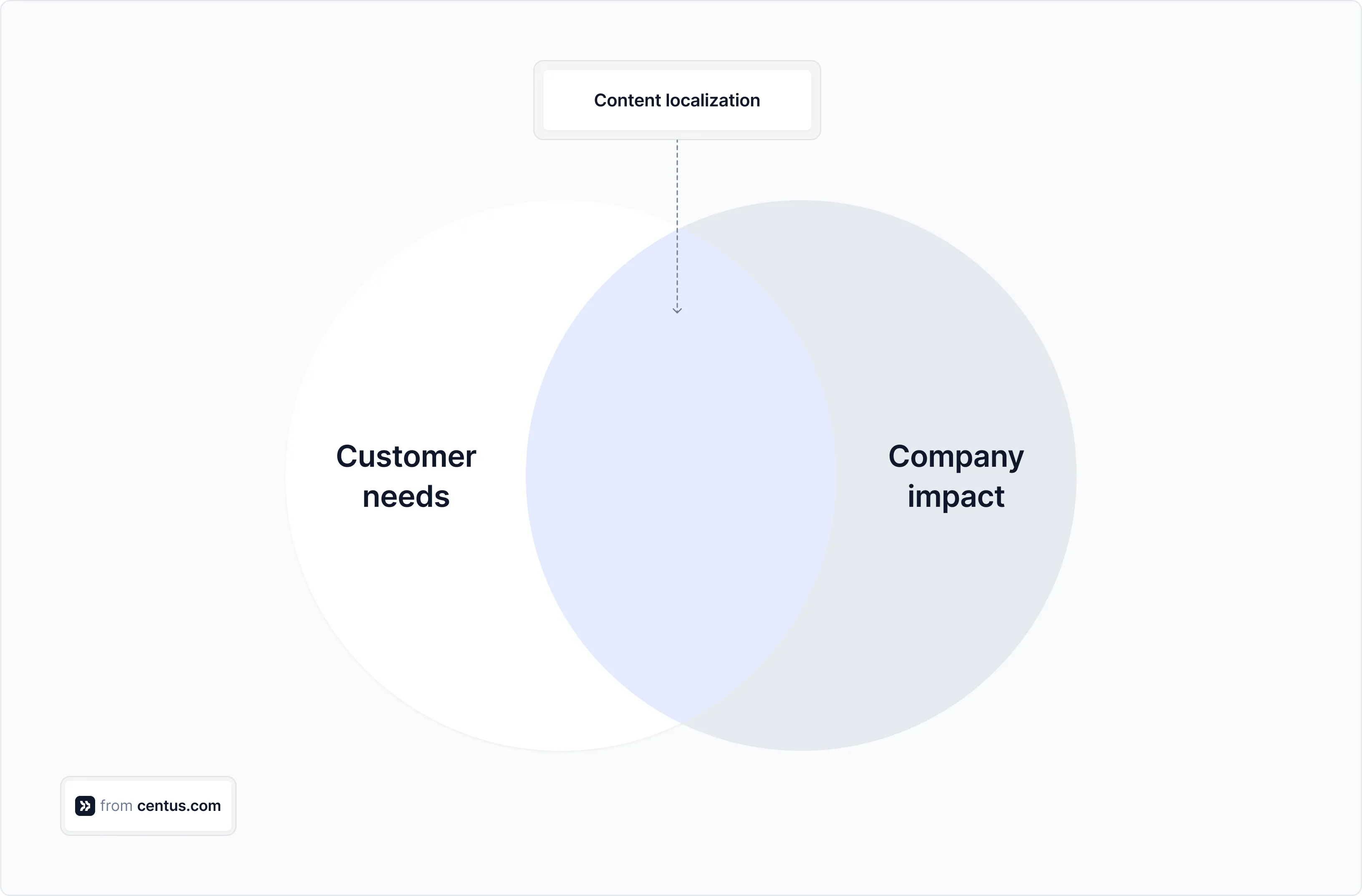
Jargon aside, localize everything that helps local customers buy your product and helps you sell it.
Let's unpack it:
Software and app localization
Product localization is table stakes. Chances are, your competitors have already localized their digital products for multiple markets. And if they haven't, congrats—here's your opening.
For software products, translate user-facing strings and adjust UI/UX. You can do it quickly using the translation and localization management platform Centus.
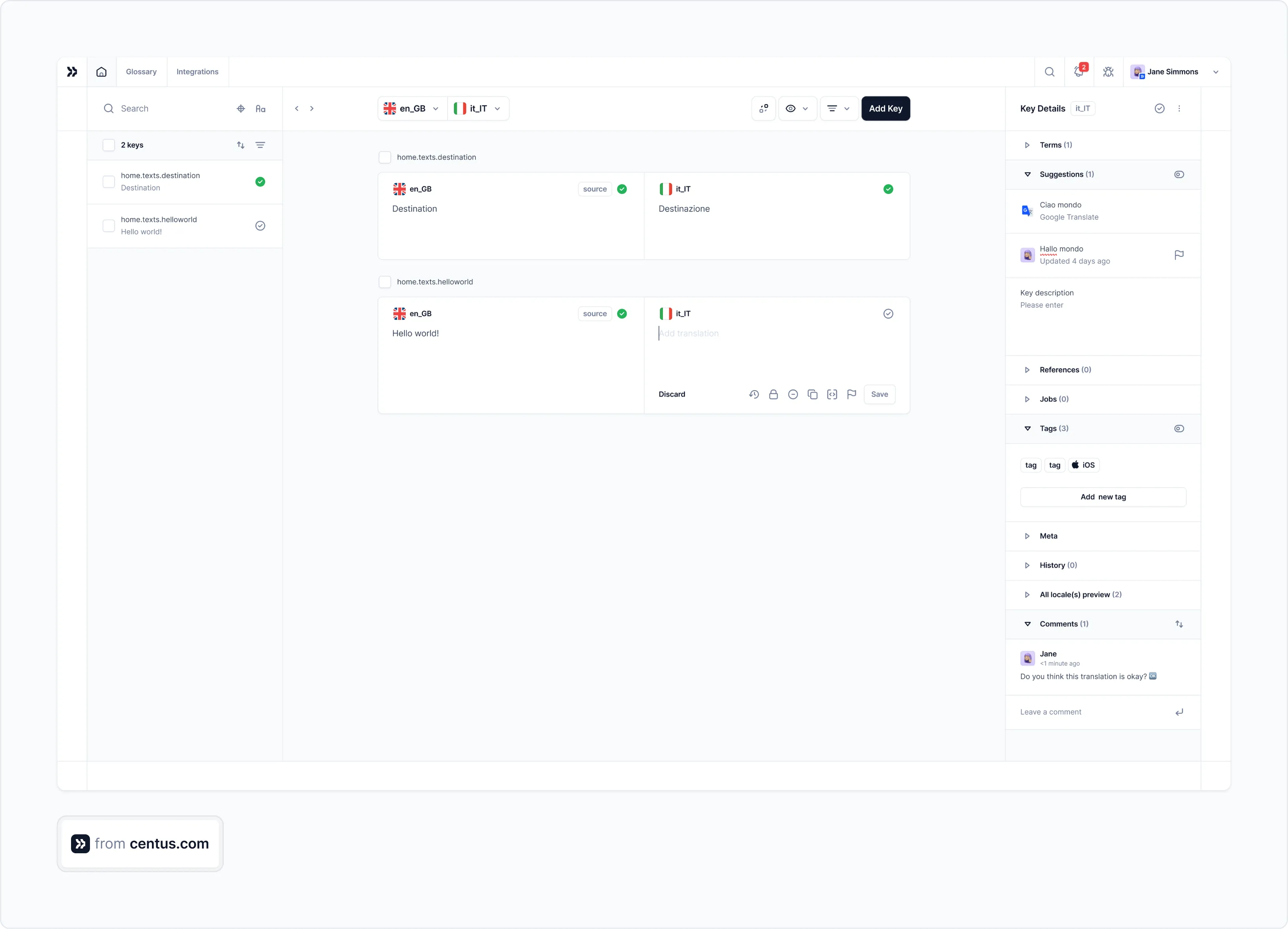
Simply upload your software strings to Centus where they can be translated automatically. Then, your team of language experts can edit the translations, ensuring their accuracy.
📘 Relevant reading: Software Localization: From Basics to Best Practices
Website localization
If you can think of any brand off the top of your head, their websites are most certainly localized. That's how important this area of localization is.
Localize all website content, including tooltips, forms, and menu items. Once again, localization management system Centus has got you covered. The localization platform supports all file formats you can throw at it—HTML, CSV, PHP, you name it.

To quickly localize a website, import your files to Centus and let your team edit automatically-generated translations. Once done, export files in a preferred format and upload them back to your website.
UI/UX and image localization
Make sure to localize your UI/UX and images. This might involve flipping the layout of your website, app, or downloadables for right-to-left languages.
To streamline the process, use Centus' convenient Figma plugin to instantly pull translations to all design elements.

SEO localization
Your search rankings might drop after localizing your content. That's why you don't simply translate and publish it.
The way to get local traffic is to optimize content with locally-searched keywords. This includes the content itself, meta titles, descriptions, and headers.
SEO technology and tools like Ahrefs are your go-to choice here.
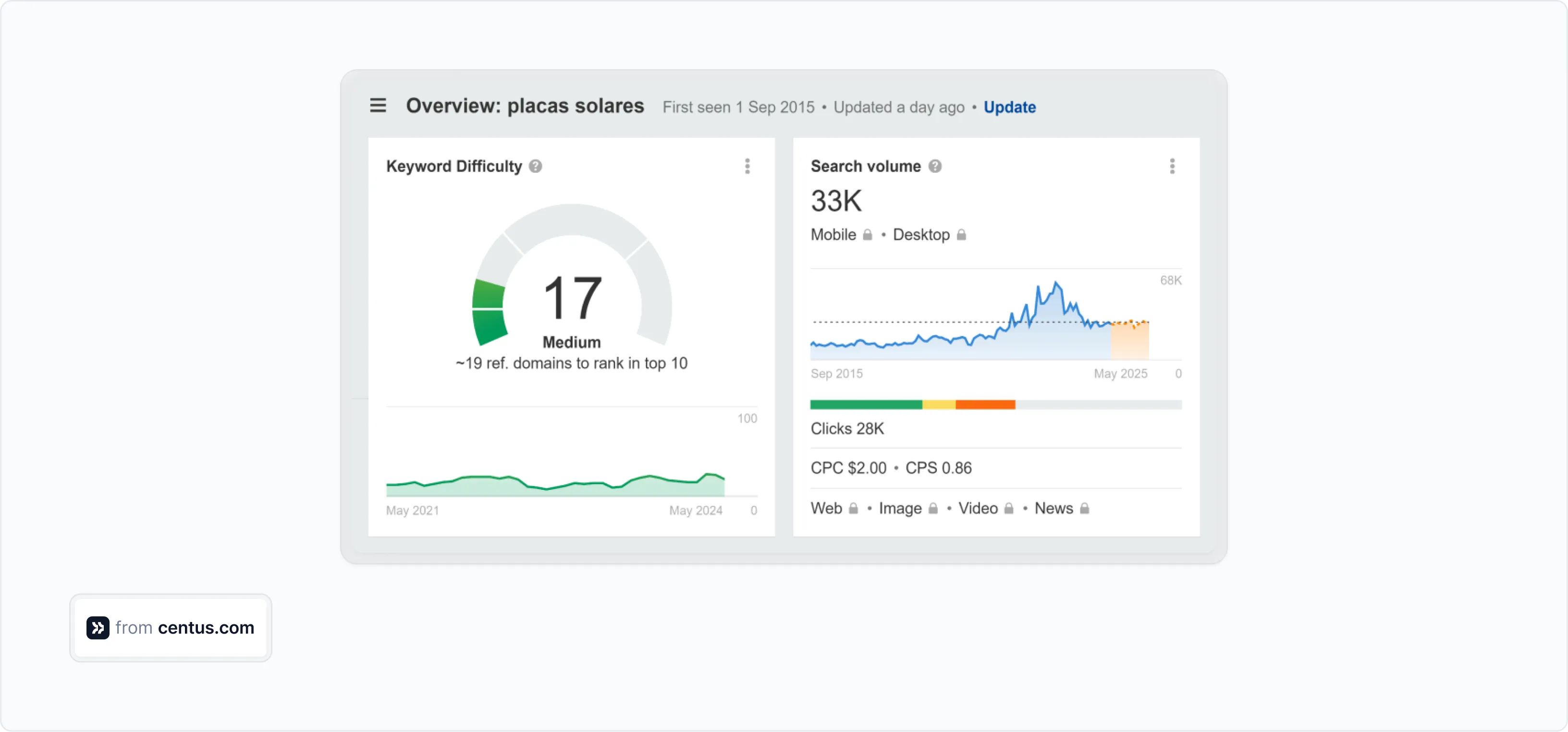
📘 Relevant reading: A guide to international SEO
Marketing materials localization
Collect and audit your marketing materials. Do they need adjustments to click with local audiences?
In most cases, mere translation would suffice. A Danish-American software company Zendesk, for instance, translates their social media ads without redesigning them.

However, occasionally you might want to completely redesign your ads, emails, ebooks, white papers, and other marketing assets.
Zendesk goes so far as to create unique marketing content for some markets. A case in point is their webinars created in collaboration with Spanish experts, which are heavily promoted on social media.

Smart. If your budget can accommodate it, you should also create custom content to generate local buzz.
📘 Relevant reading: Marketing localization guide
User guides and customer support
If you've localized a physical or digital product, make sure customers can learn how to use it. Budget for localization of user guides, manuals, knowledge bases, and other customer support materials.
Similarly, don't neglect local customer support channels such as a dedicated hotline, chat, or email.
📘 Relevant reading: Technical translation guide
Legal and regulatory compliance
Not the most exciting, but still a crucial area of localization.
Work closely with local legal experts to ensure compliance with these regulatory requirements:
- General Data Protection Regulation (GDPR)
- Copyright laws
- Trademark laws
- Patent laws
- Advertising and marketing regulations
- Product labeling requirements
- E-commerce regulations
- Employment contract translation
3. Manage the project schedule
Now you have a general idea of what should be done to localize your product or solution. But if you are the one who's going to carry out the project, a general idea won't suffice. You need to define exact activities and create a schedule to keep the project on course.
But how exactly do you manage the localization project schedule?
Here's how.
Identify localization tasks
First, identify all activities involved in your localization project.
The level of granularity you go into isn't as important as simply ensuring you do it upfront. Because identifying localization activities can spare you from the nightmare of realizing that a prerequisite activity has been overlooked.
To keep things organized, break down tasks across the project lifecycle: pre-production, production, and post-production.
Here's what it might look like for content translation:
Pre-production stage:
- Create a content inventory
- Audit content
- Estimate a translation budget
- Obtain input from the legal, marketing, technical, and SEO teams
- Prepare a term base and translation memories (if applicable)
- Hire translators
Production stage:
- Translate content
- Edit content
- Review content
Post-production stage:
- Generate a target document
- Update translation memories and term bases
- Collect and process invoices
Sequence localization tasks
If you sequence all localization activities, you'll understand the dependencies between tasks. Even better: You'll understand which tasks can be performed simultaneously. Here at Centus, our content localization processes are sequenced as follows:
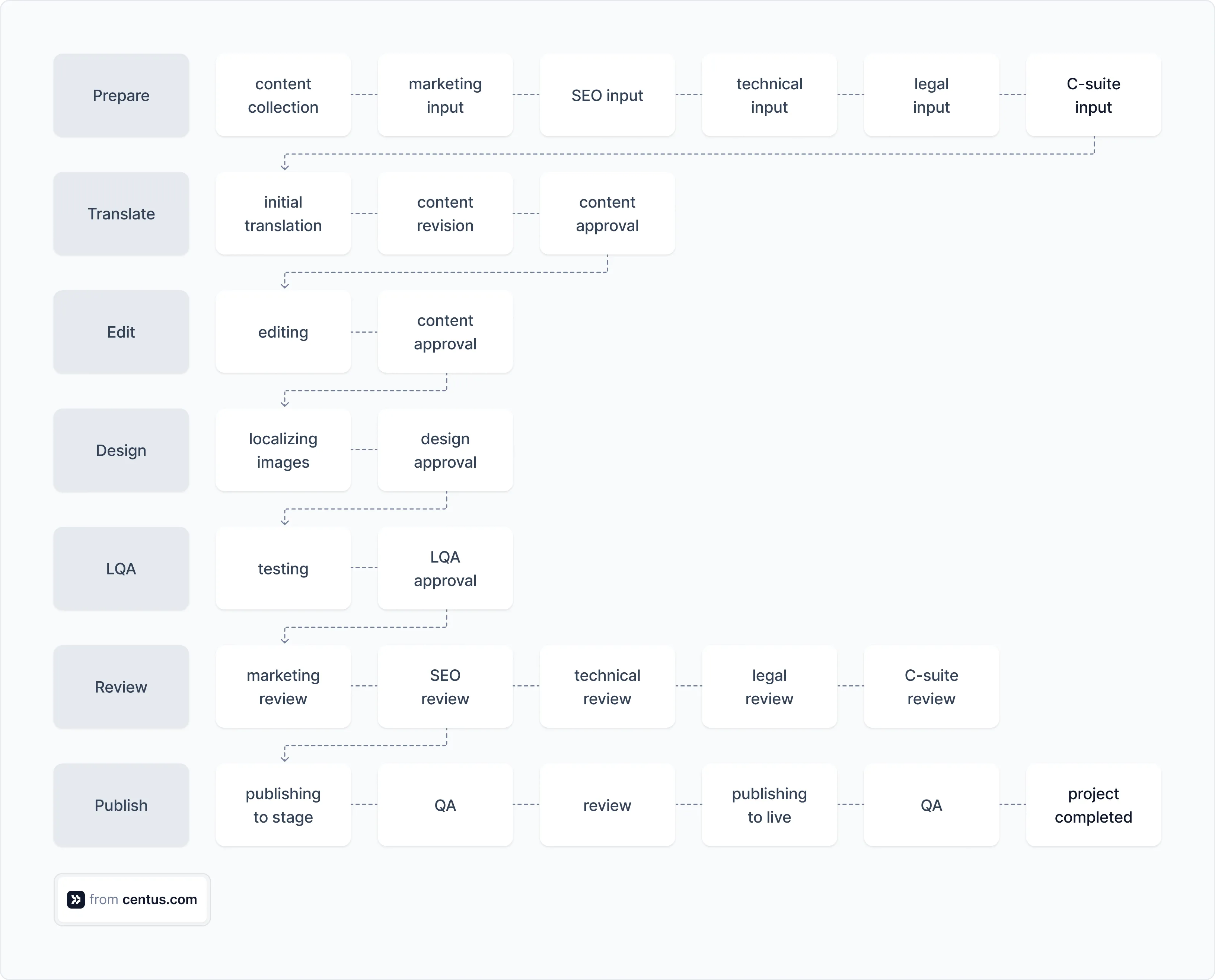
Based on your company's hierarchical structure and the specifics of your project, you can add, omit, or perform certain tasks in parallel. For example, you can't start reviewing content until it's translated. However, your team can simultaneously collect content, audit content, and prepare a term base.
To streamline your localization process, categorize all tasks as those that can be performed:
- Finish-to-Start (FS): Complete one task before starting the next.
Example: Finish auditing content, then start creating a content inventory
- Finish-to-Finish (FF): One task cannot be finished until another task is unfinished.
Example: Translation cannot be completed until editing is completed, as revisions might be needed.
- Start-to-Start (SS): Two tasks can be performed simultaneously.
Example: Audit content while estimating a translation budget.
To cut your project duration, not only can some tasks be performed simultaneously, but even the same task can be performed simultaneously by multiple contributors. More on it below.
Estimate the duration of tasks
Arguably the hardest part of the scheduling process is estimating the duration of tasks.
Fortunately, many localization projects share a similar structure and activities. Once you have an estimate for one language pair, you can reuse it—with minor adjustments—for other language pairs. Or even other localization projects.
Let's see how you can estimate the duration of translation tasks:
Suppose you have 50,000 words to translate in 12 days. With an average translation speed of 3,000 words per day, a single translator would finish the project in 17 days. How can you meet the deadline? A team of 3 translators working simultaneously would complete the project in about 6 days. After each batch is ready, it needs to be edited and harmonized. Here, you might need the help of 3 editors and 1 harmonizer.
💡 Harmonizer is an expert, often a professional editor, who ensures uniformity across translation batches. They use translation memories and glossaries to ensure consistency in terminology, tone, and style.
If my math checks out, then:
- 3 translators process 9,000 words per day for 6 days
- 3 editors process 22,500 words per day for 2 days
- 1 harmonizer processes 16,500 words per day for 3 days.
Thus, the project will be completed in 11 days, leaving you with 1 day of float.
This day of float is critical for localization projects, as it buffers you against unexpected delays. And trust me, those are more than likely to pop up.
But don't take my word for it. Yulia Zubkova, Localization Manager at NAKIVO says:
💬 "If a translator claims their productivity is significantly above the industry standard of 3,000 words per day, assume their real productivity is 20% lower. This way you'll get enough leeway to account for delays."
Monitor the schedule
With the duration of tasks estimated, you need to monitor the schedule. For a comprehensive view of all activities, you can't go wrong with a Gantt chart in a spreadsheet.

Column C shows the progress percentage. How can you track it?
Localization progress tracking is super simple with Centus, where you can see progress for each translation task across all language pairs.
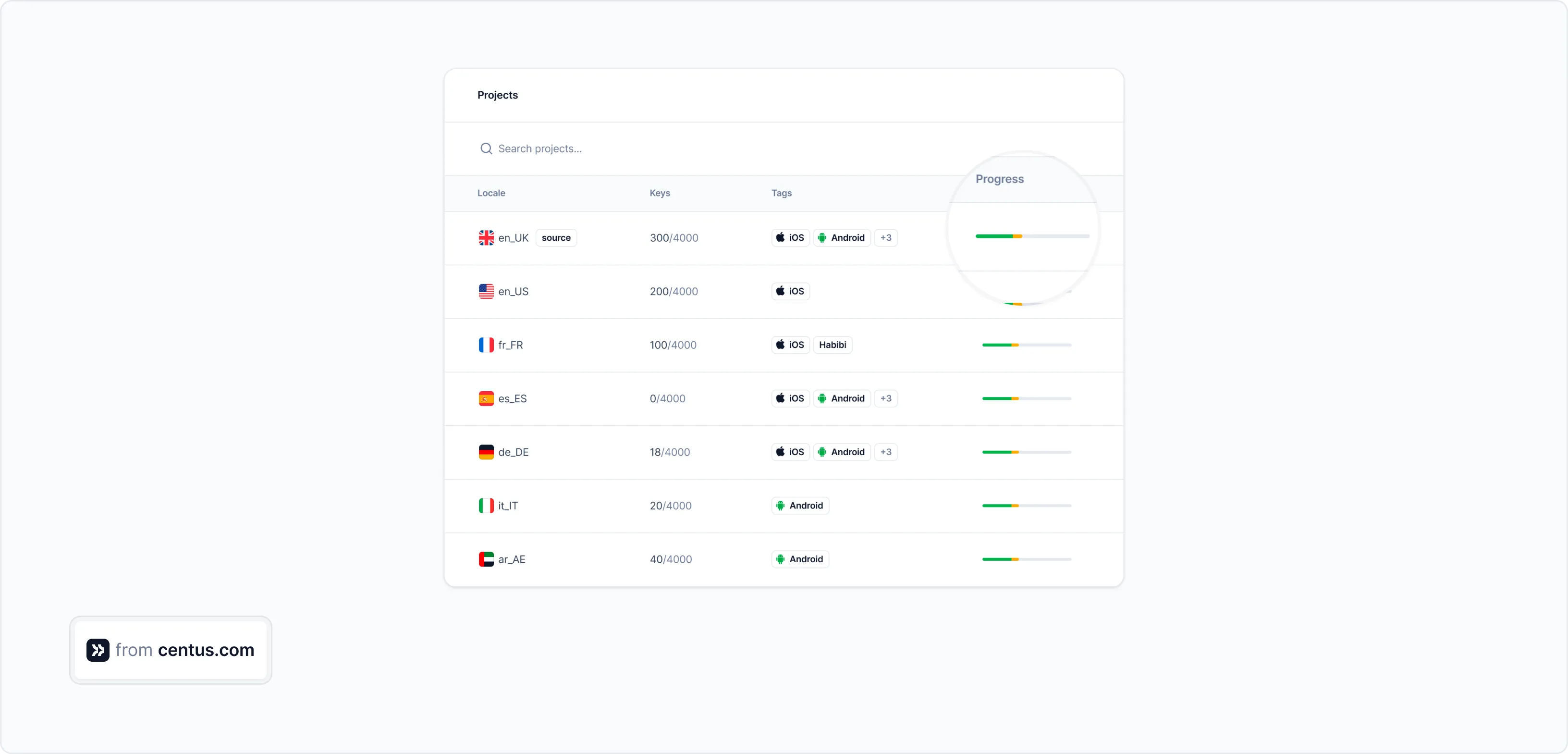
4. Manage the project budget
Translation and editing will account for the bulk of your localization budget. The rest should be allocated to software localization, image localization, video localization, and other miscellaneous tasks.
It seems counterintuitive, but the less math you perform at the start, the better. Initially, you just need something you can actually take action on. You need a localization project baseline that you can adjust as you go.
Here's how I do it 👇
Establish scope
To avoid the scope creep, establish exactly what needs to be localized. You don't want to uncover a treasure trove of ebooks for translation once the delivery starts.
As a general guide, you should:
- Identify the number of strings in a software product
- Identify the number of web pages
- Identify the number of ebooks, whitepapers, and other downloadables
- Identify the number of images
- Identify the number of videos
Assess source word count
Collect all documents for translation and upload them to Centus to instantly discover the source word count. As an added benefit, you'll have all documents in one place, making it easier to manage the project down the line. Remember I told you not to bother with the exact project baseline? It will change at the pre-production stage, as you start adding translation memories and term bases to your project.
With translation memories and term bases, you can arrive at a more precise weighted source word count. It will be slightly lower than the source word count due to repetitions and fuzzy matches.
💡 Note: On average, the weighted source word count is 5% lower than the source word count.
Calculate translation and editing costs
The cost of translation depends on the language pair and ranges from:
- $0.08 to $0.30 per word 💵
- $25-$50 per page 💵
- $15-$75 per hour 💵
💡 Note: Freelancers typically charge in USD or EUR, regardless of their home country.
Hopefully, I won't surprise you when I suggest opting for the 'per word' pricing when hiring freelance translators. It will help you maintain transparency and control costs.
However, there are times when you'll need to resort to the 'per hour' pricing. One such case is the final review of content on the stage server.
Speaking of reviews, you need professional editors to review all translated content.
Professional editing is 40% to 50% cheaper than translation for a given language pair and ranges from:
- $0.05 to $0.18 per word 💵
- $15 to $30 per page 💵
- $9 to $45 per hour 💵
Just like with translation, opt for the 'per word' pricing.
Factor in machine translation post-editing
If you've estimated your translation costs and realized you have more words than dollars—who doesn't?—use machine translation post-editing (MTPE).
MTPE is where human translators refine machine-translated text.
How much will it cost?
Hardly anything, if you perform MTPE in Centus.
Centus makes it super easy to batch translate and edit content. Your translators can then review translations, adjust them as necessary, and select the most suitable translations from MT-generated suggestions.
Freelance translators charge from $0.02 to $0.05 per word for MTPE 💵.
Account for software subscription fees
Use a localization management platform, like Centus, to handle your project.
Well, in the interest of sharing real practices in the business world, not all companies use localization solutions. Those that are just starting out, try to organize localization manually. And it really works for some projects.
However, if you want to localize your app or website into more than three languages, you'll be better off using a localization management solution. It will help you organize localization resources, coordinate project contributors, and stay within budget and deadlines.
Subscription fees for localization software range from $120 to $1,045 per month 💵.
The fees vary based on the number of available seats, hosted keys, and features. Learn more about localization management software pricing here.
5. Hire translators and editors
First things first, decide whether you want to work with language service providers (LSPs) or freelance translators.
Choose LSPs when:
- You need to translate into dozens of languages simultaneously
- You need multimedia translation
- You need legal, medical, or other certified translation
- You need urgent translations
Choose freelancers when:
- You have a small project with several target languages
- You need to reduce translation costs
- You can afford hands-on project management
- You have flexibility in scheduling
💡 Note: Freelancers' low translation rates are a major selling point, as LSPs typically add a 40% margin on top of standard translation rates.
If you decide to use LSP services, make sure to sign the client-LSP agreement. The document should stipulate the obligations of the LSP, confidentiality clauses, payment terms, and other conditions to be met.
📘 Relevant reading: A guide to hiring translators.
6. Organize localization workflows and monitor progress
Let's face it, once you hand over translation tasks to project contributors you lose a lot of control over the project. Now you are left waiting for an email notifying you that another batch of translations is ready. Or are you?
For effective project monitoring and coordination, Centus is the way to go. With Centus, you can bring translators, editors, SMEs, designers, and developers into one place to foster teamwork. And you can see exactly what and when is done to keep the project on track.

Do you want to wait until a batch of translations is ready, only for an editor to request major revisions? Wouldn't it be better if all contributors could instantly help each other?

Using Centus, you can integrate collaboration into all localization workflows.
It goes like this 👇
Add all project contributors to a collaborative environment where they can:
- provide translation context
- share screenshots
- offer feedback
In Centus, your team members can efficiently perform:
- translation
- editing
- design
- review (marketing, SEO, technical, legal, C-suite)
- QA
Sounds like something you might need? Try Centus now!
Parting thoughts and extra tips
Congratulations! You're now equipped to tackle the most challenging localization projects.
Before you dive in, let me share a few extra tips to make this post extra good. If I succeeded, maybe share this post to spread that goodness around 🙂?
Here are three big don'ts of localization management:
- Don't manage the project manually: Use a localization management tool.
- Don't sacrifice the quality of translations: You'll lose more money down the line by losing customers.
- Don't rush the pre-production stage: Ascertain document update dates, convert documents, create translation memories and term bases.
And here's a bonus 'don't': Don't let this lengthy article intimidate you. After translating your content into just several languages, you'll quickly get the hang of localization management.
Until then, use the next best thing—Centus' advice:
Smooth sailing!
Get the week's best content!
By subscribing, you are agreeing to have your personal information managed in accordance with the terms of Centus Privacy Policy ->
Keep learning
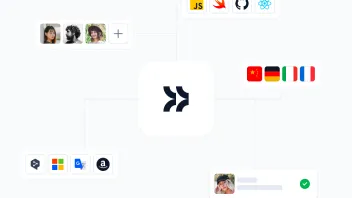
12 min. read
How to Build a Localization Workflow
11 min. read
What Is Localization? A Comprehensive Overview
18 min. read
7 Localization File Formats Explained with Examples
7 min. read
Localization Specialist Role and How to Become One

8 min. read
Key Localization Challenges and Solutions in 2025
7 min. read